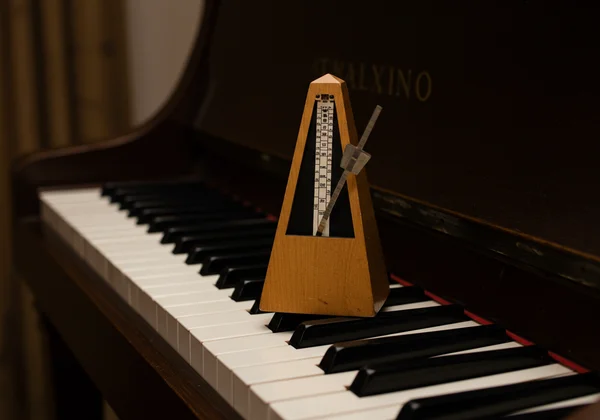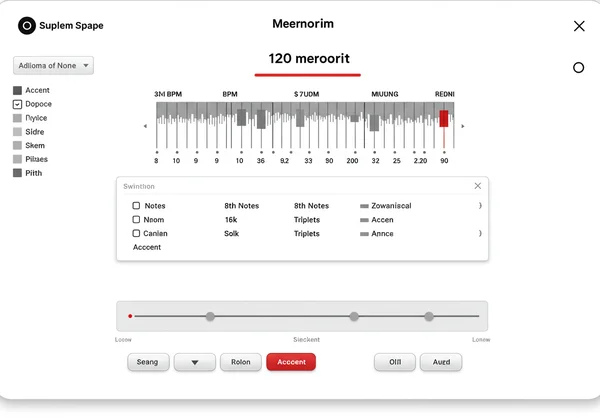Online Metronome for Piano: Master Expressive Play
For many pianists, the journey from hitting the right notes to making real music can feel like a huge leap. You practice your scales, nail the chords, but the performance still sounds robotic and lacks emotion. How can a metronome improve my piano playing beyond mere accuracy? The answer lies in transforming this simple time-keeping device into your most powerful tool for musicality. This guide will show you how a metronome for piano practice, especially a versatile one like the free tool on our site, is the secret to unlocking dynamics, phrasing, and the expressive voice of your instrument.
Too often, we see the metronome as a rigid taskmaster, forcing us into a strict rhythmic box. But what if we viewed it as a blank canvas? A stable, reliable pulse gives you the foundation upon which you can paint with sound, controlling every nuance of your performance. Let’s explore how to move beyond mechanical practice and start playing with true expression.

Why Piano Players Need a Metronome for Expressive Play
A steady beat isn't just about timing; it's the heartbeat of musical expression. Without a solid rhythmic foundation, attempts at expressive techniques like rubato (a slight speeding up and slowing down of the tempo) can sound sloppy rather than intentional. A metronome provides the essential framework for developing both precision and artistry.
The Foundation: Building Solid Piano Rhythm Practice
Before you can bend the rules, you must first master them. Consistent piano rhythm practice with a metronome internalizes a steady sense of time. This internal clock is what allows professional musicians to play with such effortless groove and precision, even during the most complex passages. When your timing is secure, you free up mental energy to focus on higher-level musical elements.
Start by setting a slow, comfortable tempo for a piece you know well. Focus on aligning each note perfectly with the click. This builds muscle memory and a deep-seated rhythmic awareness. Using a tool like our online metronome piano is ideal because you can easily adjust the BPM (beats per minute) with a simple slider or by typing it in, finding the perfect speed for any exercise.
Beyond BPM: How Metronome Assists Musical Phrasing
Musical phrasing is what makes a melody sing. It’s the art of grouping notes into musical sentences, complete with breaths and emphasis, much like spoken language. A metronome helps you define these phrases with clarity. You can practice starting a phrase right on the beat and ending it with precision, giving your music a clear and coherent structure.
For example, practice a four-bar phrase by placing a slight emphasis on the first beat of the first bar. The steady click of the metronome ensures that your sense of pulse remains constant, allowing your intentional phrasing to shine through without sacrificing the underlying rhythm. This subtle control is a key component of expressive playing.
Using Your Online Metronome for Dynamic Control & Articulation
Once your rhythm is solid, you can begin to explore the vast world of dynamics (the volume of the music) and articulation (how individual notes are played). These are the elements that add color, emotion, and personality to your performance. A metronome is your indispensable partner in practicing these techniques with accuracy.

Cultivating Crescendos & Diminuendos with Precision
A crescendo (gradually getting louder) or a diminuendo (gradually getting softer) can easily cause a player to speed up or slow down unintentionally. Practicing these dynamic shifts with a metronome teaches you to separate volume control from tempo control.
Here’s an exercise: Set your metronome to a moderate tempo, like 80 BPM. Play a simple C major scale over two octaves. For the first octave, execute a smooth crescendo from piano (soft) to forte (loud). For the second octave, perform a diminuendo back down to piano. The metronome’s click will keep you honest, forcing you to maintain a steady speed as you adjust your touch on the keys. This is a fantastic way to build control and make your dynamic changes sound deliberate and powerful.
Sharpening Your Articulation: Staccato, Legato, and More
Articulation breathes life into notes. Playing staccato (short and detached) or legato (smooth and connected) requires incredible rhythmic precision. A metronome helps you perfect the timing of each note's attack and release.
To practice staccato, try playing a scale where each note is a crisp, short sound that ends well before the next click. The silence between the notes should be as rhythmically precise as the notes themselves. For legato, focus on connecting each note to the next seamlessly, with one finger lifting at the exact moment the next one plays, all while staying perfectly in time with the beat. Using a reliable rhythm practice tool ensures the feedback you get is perfectly accurate.
Advanced Metronome Techniques for Piano Mastery
For the serious musician looking to push their skills to the next level, the metronome becomes a sophisticated training partner. The features available on our advanced online metronome can help you tackle complex rhythms and develop a truly unshakable internal pulse.
Practice with Subdivisions and Accents for Complex Rhythms
Many musical pieces, from Bach to jazz, involve intricate rhythmic patterns. Using a metronome that offers subdivisions is a game-changer. Using our online metronome, you can select eighth notes, sixteenth notes, or even triplets. Hearing the subdivision click helps you place complex rhythms accurately within the main beat.

For example, if you’re struggling with a passage full of sixteenth notes, set the metronome to click on every sixteenth note. This breaks down the rhythm into manageable chunks. You can also use the accent feature to emphasize the first beat of each measure, helping you stay oriented in difficult time signatures. This makes it an essential time signature metronome for any aspiring professional.
Silent Measures & Accelerando/Ritardando Training
One of the most powerful advanced techniques is practicing with "silent measures." Set your metronome to play for one measure and then be silent for the next. Your task is to continue playing in perfect time during the silent measure and land exactly on the downbeat when the click returns. This exercise is the ultimate test of your internal clock.
Furthermore, while a metronome’s job is to be steady, you can use it to practice gradual changes in tempo (accelerando and ritardando). Set a starting BPM and manually increase it by 2-3 BPM every few measures to practice speeding up smoothly. This disciplined approach ensures your tempo changes are controlled and musical, not accidental. Ready to start your practice?
Elevate Your Piano Performance with Consistent Metronome Practice
Forget the stereotype of the metronome as just a click track. It's truly a versatile, powerful, and essential ally for any pianist serious about moving beyond technical proficiency to achieve true musical expression. By using it to build a solid rhythmic foundation, master dynamics and articulation, and tackle advanced rhythmic challenges, you can unlock a new level of artistry in your playing.
Embrace the steady pulse as your guide, not your limitation. Let it be the canvas for your musical ideas. We invite you to try our free tool today and discover how its rich features can transform your practice sessions and elevate your piano performance.

Frequently Asked Questions
How can a metronome improve my piano playing?
A metronome fundamentally improves your playing by developing a rock-solid sense of rhythm. This precision is the foundation for all other musical elements, including phrasing, dynamics, and articulation. It helps you play cleanly, confidently, and in sync with other musicians.
What is a good tempo for piano practice?
There is no single "good" tempo; the best tempo is one that allows you to play a passage perfectly without mistakes. Always start slower than you think you need to. Once you can play a piece flawlessly at a slow speed, you can gradually increase the BPM using a tool like our online BPM counter.
Can an online metronome help with expressive playing?
Absolutely. By providing a stable rhythmic backdrop, an online metronome allows you to practice expressive techniques like crescendos, phrasing, and articulation with precision. It trains you to control these elements intentionally, rather than letting them disrupt your timing.
How do I use metronome subdivisions for piano?
Use subdivisions to break down complex rhythms. If a passage has many fast notes (like sixteenths), set the metronome to click on every subdivision. This makes it easier to place each note accurately. Our tool lets you choose various subdivisions, which you can explore here.
What does 4/4 time mean in piano music?
4/4 time, or "common time," means there are four beats in every measure, and the quarter note gets one beat. It’s the most common time signature in Western music. You can hear this clearly by setting our online metronome to 4 beats per measure with the accent on the first beat.